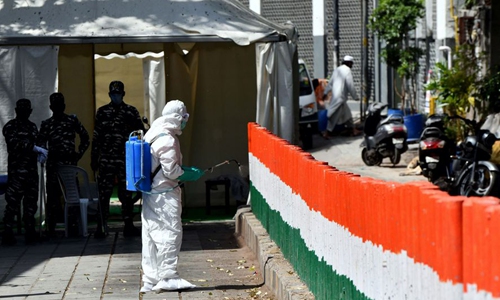IN-DEPTH / IN-DEPTH
India's four types of anti-China groups imperil bilateral ties
India's anti-China groups imperil bilateral ties

A health worker sanitizes an area near the Nizamuddin mosque in New Delhi, India, on April 10, 2020.Photo:Xinhua
Since skirmishes broke out on the China-India border in May, Indian society is flooded with rising anti-China sentiment with celebrities, media and the public openly calling for boycott of Chinese products, "taking a revenge" or "making China pay" for deaths in the clashes, observers found.
Amid the clashes at Galvan Valley, Indians' anti-China sentiment rose on social media with many posts calling for an "all-round war."
Strong Sinophobia
"If I have gun I [will] kill at least 100 Chinese soldiers before I die," read one post on Twitter.
Another net user wrote "Will destroy your all China. With Atom and Hydrogen bomb."
Some posts recalled the two countries' 1962 war and claimed a new war with China would be revenge.
Indian anti-China sentiment has expanded amid clashes on the China-Indian border that caused casualties for both sides.
According to a report released by Pew Research Center in December 2019, only 23 percent of people in India had a favorable opinion of China, ranking the second least after Japan among the 34 countries and regions surveyed.
The report showed Indians are uncomfortable with the rise of China especially in economic terms. As many as 61 percent of Indian respondents said China's growing economy is bad for their country, while only 20 percent said it is good. Similarly, 54 percent of them viewed Chinese investment as a bad thing as it "gives China too much influence" in India.
Engineer and educator Sonam Wangchuk, the inspiration of a main character in the Bollywood blockbuster 3 Idiots, appealed to boycott made-in-China products on Twitter in late May, which has gained 8,400 retweets as of Wednesday.
In a video Wangchuk uploaded on YouTube, he listed a few Chinese mobile phone apps that are popular in Indian including TikTok, and called on Indian users to "uninstall Chinese apps (to) develop and support Indian apps.
This nationalist, anti-China sentiment was echoed by the viral "success" of an Indian app "Remove China Apps," which had reached 5 million downloads within two weeks before being taken down from Google Play Store, reported Business Insider on June 3. Nearly 160,000 Indian users were said to have given it a five-star rating.
The hostility against China has ironically hurt Indians themselves, as 185 nurses reportedly quit their jobs in hospitals in Kolkata for the "discrimination and racism" they had faced amid the pandemic. In a video published on India-based news site Times Now on June 4, a nurse said they were mistaken as Chinese and were insulted by locals.
Xiao Jun, a Chinese observer who has lived in India for a few years, told the Global Times that anti-China forces in India can be normally divided into four types. The first are the "diehards" who see China as a hostile power, often deeply affected by the Sino-Indian war of 1962, in which some of their loved ones were killed.
Xiao said the second type is ultranationalists, who have lobbied against any Chinese goods like Huawei's technology. Those extreme nationalists are not only against China but any country they regard as hurting their national pride.
The third group is anti-China politicians, who use "anti-China sentiment" as a stepping stone for their career pathway, said Xiao. They go against China for their own interests and exploit public sentiment amid changing global relations.
The fourth group is India's intellectuals and the middle class who are sometimes obsessed and even have blind obedience to Western values. They tend to believe the demonized characterizations of China described in some Western media, said Xiao. This fourth group criticizes China systematically against its political institutions and social rules, but without hostile remarks, he added..
Eroded mutual trust
China and India have lacked strategic mutual trust, as many observed, after the two main powers suffered from a series of conflicts such as the war in 1962, India's 1998 nuclear test, India's bid to join the Nuclear Suppliers Group in 2018, India's rejected application to be a permanent member of the UN Security Council, and perhaps most significantly, the China-India border Doklam standoff in 2017.
Some deeply rooted incompatible issues also fuel in the unstable bilateral relationships such as India's support to separatist Dalai Lama, their concern about China's friendly relationship with Pakistan, and India's trade deficit with China.
The lack of strategic mutual trust between two can also be seen in the weak economic and trade interactions and exchanges between China and India. The bilateral trade volume is less than $100 billion every year and the annual personnel exchanges have barely exceeded 1 million.
The level of interaction is far less than that of China with its smaller neighbors. Both historical rifts and current intense ties are part of causes for such cold friendship, said Xiao, telling that many Indians are still unwilling to give up their suspicion and anxiety about China's development.
Meanwhile, the government has been smearing the China-Pakistan Economic Corridor, which it claimed to be in disputed territories of Pakistan and India.
Stereotypes, historical bearings and ideological confrontation are part of main factors behind Indians' unfavorable impressions to China, while stereotypes held by some Chinese about India further widens the gap.
